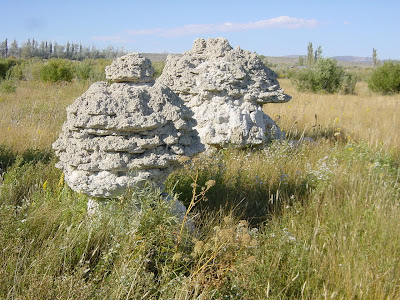The High Sierra Institute at Baker Station is located in the center of some of the most fascinating geological features in California. From our base at the institute, we will be able to explore the record of volcanism in the High Sierra and the valleys to the east (including Mono Lake and the ghost town of Bodie), and the glaciation of the range from both sides of the Sierra Crest. We will have access to plutonic and metamorphic rocks of the highest part of the Sierra near Tioga Pass, and the fascinating rocks of the Western Sierra Metamorphic Belt near Sonora and Columbia. This is a great opportunity for local earth science teachers to learn some interesting geology in their home region. Membership is not required to participate, but you will have an opportunity to join NAGT if you wish, and to purchase field guides and resources published by the Far Western Section.
Sonora Pass reaches 9,623 feet and is the second highest paved highway in the Sierra Nevada. The scenery in the area is spectacular, and includes exposures of the granites of the Sierra Nevada batholith, a complex sequence of Neogene volcanic rocks, and a rich record of Pleistocene glacial activity.
Some of our field trips will take us east of the crest of the Sierra, into the Bridgeport and Mono Lake Valleys. There is a rich record of Plio-Pleistocene volcanism and faulting to investigate, and some of the best glacial moraines to be found anywhere.
Mono Lake is America's "Dead Sea", a vast alkaline lake with strange tufa towers and millions of migratory birds. We will have a chance to talk about environmental challenges at the lake caused by the diversion of incoming streams by Los Angeles.
Here is the complete line-up of events:
Trip 1: Walker Lane Belt
Pull-apart Volcanism and the 11- 9 Ma Sierra Crest Graben at Sonora Pass:
The one-day field trip will take place at Sonora Pass, in the newly-recognized
11- 9 Ma Sierra Crest Graben. Geologic highlights will include spectacular
views of the Sierran crest, and in outcrop we will examine the Miocene graben
fill. Basal deposits consist of giant landslide deposits, shed from Early
Miocene arc volcanic sections on the graben shoulders. The landslide megablocks
provide a smorgasbord of arc volcanic lithofacies, which we will identify in
outcrop. The landslide megabreccia is overlain by by graben-ponded latite lava
flows, which we will also study in outcrop. The trip will provide also
overviews of the topographic evolution of the Sierra Nevada.
We
will spend the day hiking (about 3 – 4 miles round trip), with an elevation
gain and loss of about 1,000’. Please wear hiking boots, a sunhat, and a
daypack with 2 – 3 quarts of water, lunch, sun screen, and a rain parka/wind
breaker. Tour Leader: Cathy Busby
Trip 2: Geology of the Eastern Sierra Nevada
between Sonora Pass and Mono Lake: A tour of some of the eastern Sierra
Nevada, including Mono Lake, Black Point, Lundy Canyon, Bodie Ghost Town,
Bridgeport Valley, the West Walker River, and Sonora Pass. Easy to moderate
hikes only. Leader: Garry Hayes
Trip 3: Geology & Climatology of the Saddlebag
Lake Region, Tioga Pass: A five mile hiking tour along the stunningly
beautiful eastern crest of the Sierra Nevada just below Tioga Pass in the
Twenty Lakes Basin of the Hoover Wilderness Area. Tour will explore the
glacially-incised boundary zone between the Sierra Nevada Batholith and the
Eastern Metamorphic Belt with a possible spur hike to Conness Glacier, weather
and time-permitting. Moderate to strenuous hiking at elevations over 10,000’ is
required. Leaders: Ryan and Laura Hollister
Trip 5: A Tour of the Western Sierra Nevada from
Baker Station to Knights Ferry: An exploration of the volcanic, glacial,
and karst features of the western slope of the Sierra Nevada. Stops may include
the Columns of the Giants, Natural Bridges, and inverted stream of Table
Mountain. Easy to moderate hikes only. Leader: Noah Hughes
Trip 6: Geology of the Sword Lake Debris Flow: Some moderate to strenuous
hiking required. Leader: Jeff Tolhurst, Ph.D., Columbia College
Speakers:
Friday:
Going up or going
down? Evidence for late Cenozoic uplift of the Sierra Nevada, California,
connection to tectonic and processes, and alternative explanations of
paleoaltimetry. John Wakabayashi, Department of Earth and
Environmental Sciences, California State University, Fresno.
Saturday:
Walker Lane Belt Pull-apart Volcanism and the 11- 9 Ma
Sierra Crest Graben at Sonora Pass Speaker:
Cathy Busby Ph.D, UC Santa Barbara
Full details and registration forms are now posted at http://nagt-fws.org/conferences.html. Hope to see you there!







1 comment:
Sounds like fun!
Post a Comment